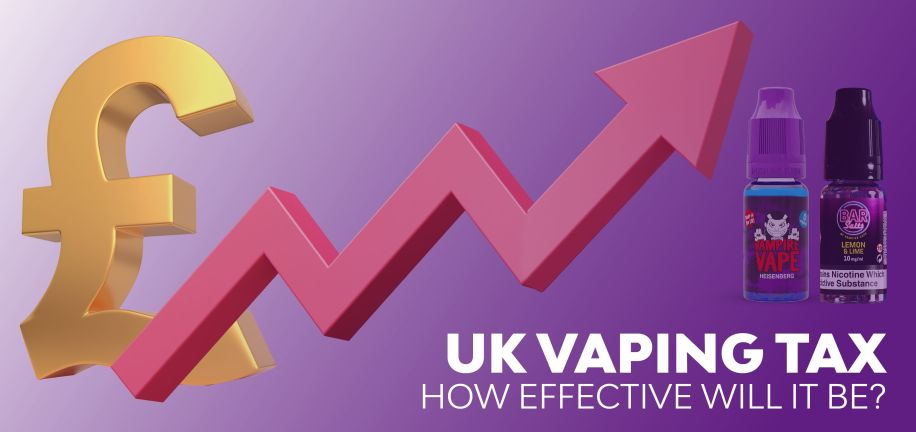
What is VPD?
The vape tax in the UK, officially known as the "Vaping Products Duty" (VPD), is a tax imposed on e-cigarettes and e-liquids containing nicotine. Submitted in the 2024 Budget to come into effect in 2026, the VPD aims to generate revenue for the government and discourage youth vaping by increasing the cost of vaping products.
The proposed increase:
The government has announced that a tax will be introduced on the nicotine content in e-liquid, per 10ml volume, including zero-nicotine e-liquids.

This will result in different prices for the most popular e-liquids, the 10ml freebase and nic salts:

With disposable pods containing only 2ml of e-liquid (assuming they are not banned) we expect the increase to be one 5th or 20% of the proposed duty.

It has also been announced that a one-off increase in the price of cigarettes will also be introduced at the same time, to maintain the price gap between vaping and smoking.
Predicted impact on Vaping Rates:
1.Cost Increase: The vape tax raises the price of vaping products, making them less affordable. This may deter some individuals, particularly price-sensitive consumers, from purchasing vaping devices and e-liquids.
2.Shift in Preferences: As vaping becomes more expensive due to the tax, some vapers may opt for cheaper alternatives or reduce their vaping frequency. This could lead to a decline in the overall consumption of vaping products.
3.Consumer Behaviour: Higher prices may prompt current vapers to seek alternative methods to obtain vaping products, such as purchasing from illicit sources or turning to traditional cigarettes. However, others may be motivated to quit vaping altogether or seek support to reduce their nicotine dependence.
Predicted Impact on Smoking Rates:
1.Potential Reduction: The vape tax is designed to discourage vaping, but its impact on smoking rates is unclear. Some experts argue that higher prices for vaping products could lead to a resurgence in cigarette smoking, especially among former smokers who switched to vaping as a harm-reduction strategy.
2.Public Health Concerns: If the vape tax leads to an increase in smoking rates, it could have adverse effects on public health, as smoking is associated with numerous health risks, including cancer, heart disease, and respiratory illnesses.
3.Need for Comprehensive Approach: To effectively address both vaping and smoking rates, policymakers may need to implement a comprehensive approach that combines taxation with other measures, such as public education campaigns, smoking cessation programs, and regulation of tobacco products.
Overall, the impact of the vape tax on vaping and smoking rates in the UK will depend on various factors, including consumer behaviour, availability of alternative products, and the effectiveness of public health interventions. Continued monitoring and evaluation will be necessary to assess the long-term effects of the tax on public health outcomes.
Will taxing vape products work?
The effects of vaping taxes on vaping and smoking in countries in Europe and America that have already introduced them vary depending on the specific policies implemented by each country. However, several general trends and observations can be made:
1.Vaping Rates: Vaping taxes have led to increased prices for vaping products, which have deterred some individuals from starting or continuing to vape. As a result, in countries like Italy, where vaping taxes are high, there was a significant decline in vaping rates and a slowdown in the growth of the vaping market. In 2023 the Italian government announced it was amending tax laws, easing restrictions on e-cigarette online sales. Politico in 2023 also suggested that the EU may have got it wrong when it came to its vaping regulations, with many EU countries seeing an explosion in vaping rates among kids, prompting Europe to rethink its approach.
2.Smoking Rates: The impact of vaping taxes on smoking rates is more complex and can vary widely. Research indicates that vaping taxes could drive some vapers back to smoking or discourage smokers from switching to vaping altogether. This has proved to be the case in many countries like the USA, where a study by Pesko showed that a $1 increase in tax on vaping products led to an increase in smoking amongst pregnant women by 6%.
3.Black Market and Illicit Trade: In regions where vaping taxes are high or where vaping is heavily regulated, like Australia, there has been evidence of an increase in the use of black market or illicit vaping products as high as 70%. This can undermine public health efforts by providing consumers with unregulated and potentially unsafe products.
Responsible Vaping Australia has said: "A thriving black market run by illegal operators has been created, willing to sell to anyone, including children. More than a million Australian adults are now vaping and most of them don't even know they are buying illegal nicotine vaping products".
4.Public Health Impact: The overall public health impact of vaping taxes depends on their effectiveness in reducing vaping among non-smokers, encouraging smoking cessation or harm reduction among current smokers, and minimising unintended consequences such as the proliferation of black market products.
5.Regulatory Response: In response to concerns about the impact of vaping taxes on smoking rates and public health, some European countries have adopted a more nuanced approach to vaping regulation. This includes measures such as differential taxation based on the relative harm of vaping compared to smoking or the introduction of evidence-based policies to support smoking cessation while minimising youth uptake of vaping. The UK government has introduced a Vaping Products Duty consultation to collect data and evidence from stakeholders and other interested parties.
In conclusion, vaping taxes and restrictions in Europe, Australia, and the USA have had varied effects on vaping and smoking rates, with outcomes influenced by factors such as tax levels, regulatory frameworks, consumer behaviour, and the availability of alternative products. Ongoing research and evaluation are essential to understand better the long-term impact of vaping taxes on public health outcomes.
